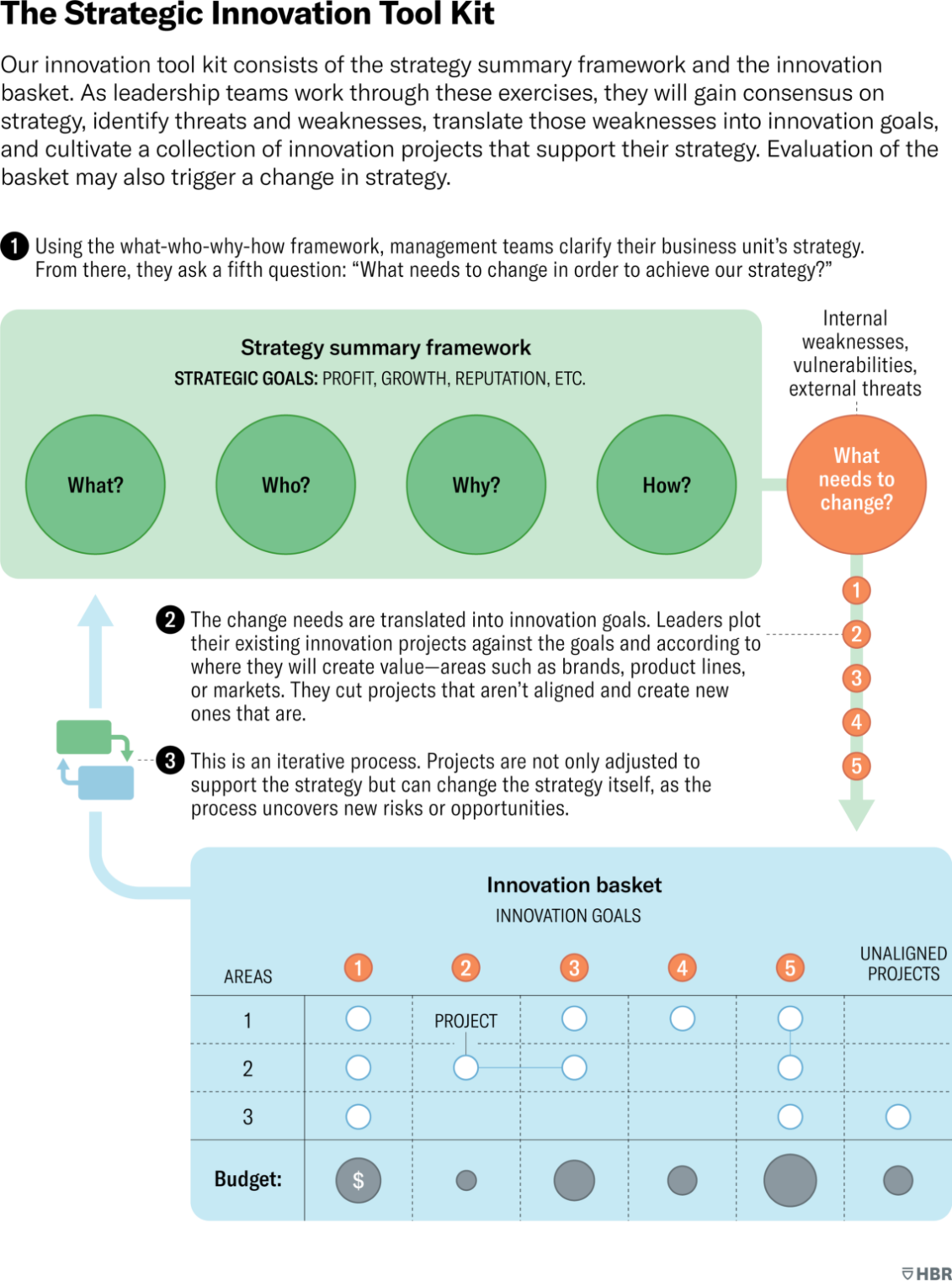Companies typically treat their innovation projects as a portfolio, aiming for a mix of projects that collectively meet their strategic objectives. The problem, say the authors, is that portfolio objectives have become standardized, and innovation projects are often only weakly related to a company’s distinctive strategy.
Therefore, companies must continually innovate with projects that align with their strategic goals. Traditional approaches to managing innovation often fall short in achieving this critical alignment. This quick review summarizes a recent article on strategic innovation, by Haijian Si, Christoph Loch, and Stelios Kavadias from the University of Cambridge’s Judge Business School.
By surveying 75 companies in China, they discovered that companies could achieve better performance outcomes through aligning innovation investments with their strategic goals. Therefore, the authors introduce a new approach called the Strategic Innovation Toolkit, designed to align innovation investments with a company's strategic goals. For the practical implication, the tool was successfully tested across 10 business units at five companies.
The toolkit consists of two components: a strategy summary framework and an innovation basket. Leaders can use the strategy summary framework to clarify their unit's strategy and determine the areas where innovation is needed to achieve their goals. Then, they can create an innovation basket by mapping each innovation project against the identified change and innovation needs. This process enables leaders to identify projects that are misaligned and develop new ones that are better aligned with the innovation needs.
Unveiling the Strategic Innovation Tool Kit
At the heart of this new approach lies the Strategic Innovation Tool Kit, a comprehensive framework designed to empower companies to forge a direct link between their innovative endeavors and their competitive strategies by bridging the gap between innovation projects and innovation needs. Let’s explore the key components of this tool kit:
- Creating Consensus on Strategy
As members of the management team often held varying understandings of their company’s strategy, getting them on the same page through strategy summary framework could help companies articulate their strategic positions. By using the widely known 3W1H (what, who, why, and how) framework plus a fifth question on weaknesses, businesses gain insights into their competitive strengths and weaknesses.
By introducing a paradigm shift from the traditional portfolio approach to a more tailored innovation strategy, the authors propose an “innovation basket” concept to denote a company’s collection of innovation projects. Unlike a portfolio, which aims to maximize returns through diversification, the basket is customized to the business unit’s strategy and organization. The top row of the basket lists the change needs from the first exercise, now framed as the innovation goals that projects are expected to address. Designing an innovation basket will help map projects to areas of the business model with valuable potential and ensure that innovation efforts are in harmony with their unique competitive strategies.
- Filling the Basket and Iteration
Evaluation of the basket may trigger a change of strategy. Projects that do not align with innovation needs are removed, making room for new ones that better support the strategy, or even identifying projects that offer previously overlooked opportunities that can enhance the strategy. This iterative process ensures that the innovation basket evolves in response to changing strategic dynamics, creating a continuous cycle of alignment and improvement. This is not a top-down deductive process, but rather a creative endeavor led by the management team and relevant experts in workshops. Frontline staff must contribute project ideas, as they often know more about what could add value to the unit than management might expect. Designing an innovation basket will initiate a discussion of opportunities and how to translate them into projects that support the unit’s competitive strategy.

After multiple iterations, the toolkit sets quantifiable goals for each innovation target, ensuring that selected projects make a substantial contribution to achieving the company's strategic goals. In addition, the authors caution against turning this process into a formal optimization exercise, as project selection is driven by algorithms that precisely weight projects based on their potential to achieve goals. The optimization process is rigid and opaque, and may rely on standard metrics that do not reflect environmental dynamics. Let’s look at how the entire process plays out in practice: the authors present two compelling case studies that realize the power of strategic innovation and bring the tool kit's transformative potential to life.
Glass, Inc.: Achieving Focus and Realignment
The optical devices division of Glass, Inc. utilized the tool kit to address growth challenges. By identifying weaknesses and mapping change needs, the company repositioned itself for success. The process led to a more targeted and impactful innovation portfolio. After realizing that Glass, Inc.'s optical devices division was working on too many unproductive niche products in response to an overly narrow performance metric, the group was able to focus on a smaller number of products with higher potential
BAT: Strategic Reinvention through Innovation
Battery company BAT underwent a strategic shift, leveraging the tool kit to identify a growth opportunity in a different technology segment. As this case illustrates, explicitly exploring the links between a company’s strategy and its innovation investments can be transformational. The process helped BAT reshape its strategic direction in its markets, leading to major new investment in a project that straddled traditional boundaries.
Conclusion
The traditional approach to managing innovation projects may lead to missed opportunities and misalignment with strategic goals, while The Strategic Innovation Tool Kit offers a groundbreaking alternative. The examples we've discussed demonstrated how the innovation basket process not only helps managers implement strategy but also shapes it, providing a window into the impact of innovation activities on strategy.
In addition, implementing the Strategic Innovation Tool Kit requires a cultural shift in organizations which involve open communication, collaboration across functions, and emotional engagement. By adopting this tool kit, businesses can achieve true strategic alignment, unlock new growth opportunities, and drive transformative change.
From left to right:
Haijian Si is the former CEO of Chinese new energy companies Linuo Power Group Co., Huanyu Power, and Hanergy Thin Film Power and is a doctoral candidate at the University of Cambridge’s Judge Business School.
Christoph Loch is the former director (dean) of the University of Cambridge’s Judge Business School and professor of management at PHBS.
Stelios Kavadias is the Margaret Thatcher professor of Enterprise Studies in Innovation and Growth at the University of Cambridge’s Judge Business School and the director of its Entrepreneurship Centre.
Summarized by Annie Jin and published in PHBS Magazine Spring 2024
*The full version of this article appeared in the September–October 2023 issue of Harvard Business Review.



















